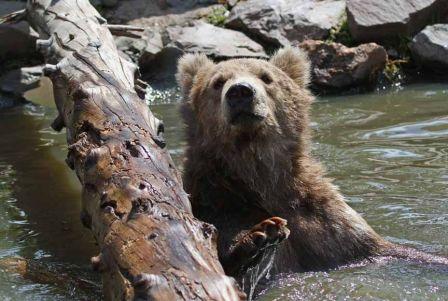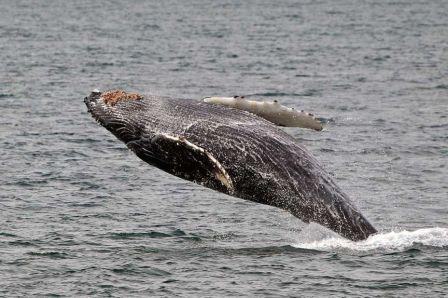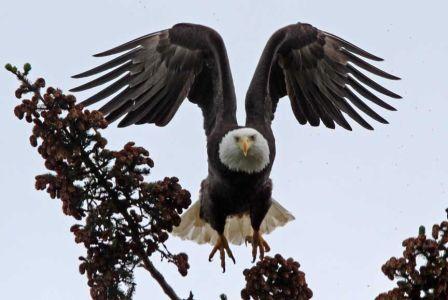Michael Daniel Ho, wildlife photographer extraordinaire, is back from Alaska. In this post, he shares Alaska traveling tips, wildlife hotspots, weather advisories, and much more. Not to mention, four amazing photos from his trip featuring: a humpback whale breaching (photographed in Juneau), killer whales (photographed in Resurrection Bay), a grizzly bear cub (photographed in Haines), and a bald eagle (photographed in Haines).
So here it is, Michael’s trip to Alaska in his own words (Beware! You will want to go to Alaska after reading this.):
The state of Alaska is big – over 663,000 square miles. It is about twice the size of Texas and over three times the size ofCalifornia. Although Alaska is home to lots of glaciers and snow, the summer months can be pleasantly warm, by Alaskan standards, of course. Protected by the Chugach Mountains and the Alaska Range and warmed by Pacific Ocean currents, Anchorage, the largest city in the state, has a temperate maritime climate. Summer temperatures can reach into the high 70s. Low humidity also contributes to Anchorage’s comfortable climate. I have been going to Alaska for photo shoots for some years now and it’s the only place in the US one can see all three species of Ursi, namely Black, Grizzly and Polar Bears, majestic Golden and Bald Eagles, plus many different species of birds (including hummingbirds) and exciting whale species, like the Blue, Humpback, Bowhead, Orca, Beluga and many other cetaceans and pinnipeds. Unless one is going to see and photograph the Aurora Borealis or the Polar Bears, usually the best months to visit Alaska are from May to September.
My itinerary usually starts from the town of Ketchikan, down in the south east and I work my way up the coast to Anchorage. There, if time permits, I either go north to Denali National Park and Fairbanks or head south west to the Kenai Peninsula and Kodiak Island. Black and Grizzly bears can be found from Ketchikan in the south, all the way up to the Brooks Range and other mountains in the southern Arctic region. Some great spots to see and photograph them are in the Tongass National Forest, near towns like Ketchikan, Wrangell, Hoonah and Haines. Kodiak Island and the Katmai National Park are prime locations to see the Kodiak brown bears. Whales are generally observed in the Gulf of Alaska, around coastal waters during the Spring and Summer months. Humpbacks are quite prevalent, especially along the Inside Passage and around the waters of Juneau and the Kenai Peninsula. Beluga whales can usually be observed around Kenai as well. Minke and Blue whales are also found in these waters with the Gray and Bowhead whales found further north in the Bering Sea. Orcas are generally found in and around Resurrection Bay. Whale photography is especially exciting during these months because a lot of the whales are active and feed almost all day due to the abundance of food, plus the need to build up fat reserves for the winter migration. Bald and Golden eagles are quite prevalent with the former rather ubiquitous around towns close to the water. As the national bird, Bald Eagles adorn the emblem of the seal of the United States. However, they are quite opportunistic birds and will not hesitate to steal and scavenge from each other. The town of Haines boasts the largest concentration of Bald Eagles in the world during the month of November due to the late run of salmon in the Chilkat River. The Alaska Bald Eagle Festival is held every year in town and attracts thousands of photographers from around the world.
Getting around Alaska is not easy and can be expensive because there are only a few main road systems and the rest of the state is very pristine and wild. For most people, flying into Ketchikan or Anchorage would be the start of their Alaskan adventure, if they are visiting the Southeastern or Northern part of the state, respectively. Fortunately, there is the robust Alaska Marine Highway Ferry System to connect most cities and towns. In addition, Alaska Airlines and its subsidiary, Horizon Air, can fly visitors into many big and small towns. Lastly, there is an army of bush pilots and a fleet of small planes and seaplanes ready to take adventurous photographers into almost anywhere not reached by the other modes of transportation. Cell phone coverage and GPS signals can be spotty or nonexistent, depending on one’s location, so good maps and a high quality compass are essential tools to bring along. For the first time visitor, I advise sticking to one or two National Parks or towns and try not to overextend oneself. There is never any guarantee in wildlife sightings and photography but if one is willing to do some thorough research before going to Alaska and is prepared to spend at least two weeks, I can assure any traveler and photographer an unforgettable experience in one of the most spectacular scenic and wildlife locations in the world.




How cool of you to not only bring this photo essay to our attention but to support another talented person in your Ocean Wild Things sphere! Thanks.